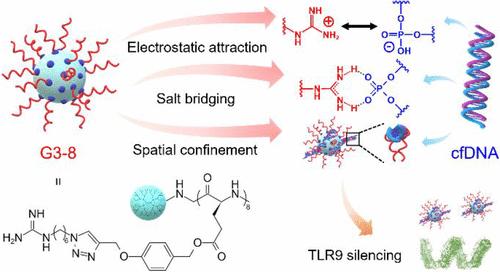Helix-Guarded Molecular Clips for Cell-Free DNA Scavenging and Treatment of Systemic Lupus Erythematosus
IF 14.4
1区 化学
Q1 CHEMISTRY, MULTIDISCIPLINARY
引用次数: 0
Abstract
Immune disorders induced by cell-free DNA (cfDNA) account for the incidence and deterioration of systemic lupus erythematosus (SLE). Scavenging of cfDNA using cationic polymers represents a promising modality for SLE management. However, they bind cfDNA mainly via electrostatic interaction, which would result in an undesired discharge of the captured cfDNA upon competitive replacement by the negatively charged serum/intracellular components. Inspired by the natural recognition mechanism of biomacromolecules via spatial matching, we herein developed a library of dendrimer-templated, spherical, α-helical, and guanidine-rich polypeptides as molecular clips for cfDNA scavenging. Upon optimization of the polypeptide length and density on the dendrimer surface, the top-performing G3-8 was identified, which could tightly confine cfDNA within the cavity between the adjacent, rod-like α-helices. As thus, the helical G3-8 but not the random-coiled analogue D,L-G3-8 enabled robust cfDNA scavenging under serum-rich conditions to inhibit TLR9 activation and inflammation. In SLE mice, i.v. injected G3-8 efficiently prevented organ failure and inhibited inflammation by scavenging cfDNA. This study provides an enlightened strategy to stably bind and scavenge cfDNA and may shift the current paradigm of SLE management.

求助全文
约1分钟内获得全文
求助全文
来源期刊
CiteScore
24.40
自引率
6.00%
发文量
2398
审稿时长
1.6 months
期刊介绍:
The flagship journal of the American Chemical Society, known as the Journal of the American Chemical Society (JACS), has been a prestigious publication since its establishment in 1879. It holds a preeminent position in the field of chemistry and related interdisciplinary sciences. JACS is committed to disseminating cutting-edge research papers, covering a wide range of topics, and encompasses approximately 19,000 pages of Articles, Communications, and Perspectives annually. With a weekly publication frequency, JACS plays a vital role in advancing the field of chemistry by providing essential research.

 求助内容:
求助内容: 应助结果提醒方式:
应助结果提醒方式:


